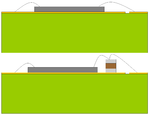sharkies
Member level 5
I have a on-chip ring oscillator running at 500MHz.
Depending on the tuning voltage, it may run as low as 250MHz.
The vdd, gnd supply of the rin oscillator is not connected to anything else on-chip
Unfortunately, I put in, little, or non existant on-chip decoupling cap.
Therefore, decoupling will have to take place offchip after 2nH of bond wire.
Will 100pF in parallel with 10pF be enough?
It would be great if capacitor arrays are available(multiple 100pF in parallel with multiple 10pF), but I don't have them
I'm assuming 100pF in parallel with 10pF in parallel with 10nF to be safe...
Does this sound reasonable?
I also have a question on the difference in the order of magnitude between the parallel caps.
Somtimes people use 1uF in parallel with 100uF. order of magnitude x100
Somtimes people use 1uF in parallel with 10uF. order of magnitude x10
which one is better in terms of lower antiresonant effect???
It seems that people have different opinions on this... Hmm.
Depending on the tuning voltage, it may run as low as 250MHz.
The vdd, gnd supply of the rin oscillator is not connected to anything else on-chip
Unfortunately, I put in, little, or non existant on-chip decoupling cap.
Therefore, decoupling will have to take place offchip after 2nH of bond wire.
Will 100pF in parallel with 10pF be enough?
It would be great if capacitor arrays are available(multiple 100pF in parallel with multiple 10pF), but I don't have them
I'm assuming 100pF in parallel with 10pF in parallel with 10nF to be safe...
Does this sound reasonable?
I also have a question on the difference in the order of magnitude between the parallel caps.
Somtimes people use 1uF in parallel with 100uF. order of magnitude x100
Somtimes people use 1uF in parallel with 10uF. order of magnitude x10
which one is better in terms of lower antiresonant effect???
It seems that people have different opinions on this... Hmm.
